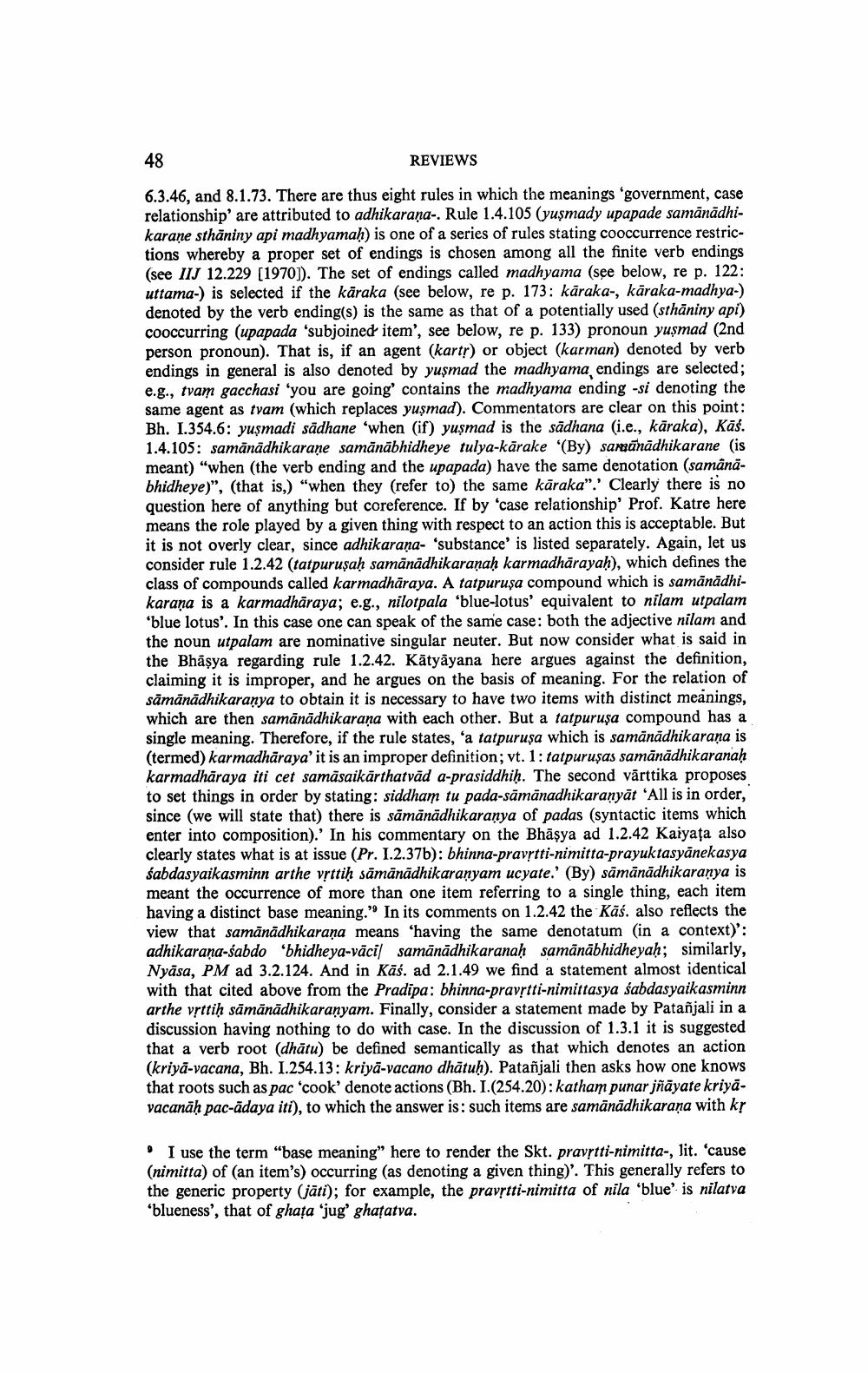________________ 48 REVIEWS lected if the kar is the same as low, re p. 133) 6.3.46, and 8.1.73. There are thus eight rules in which the meanings 'government, case relationship' are attributed to adhikarana-. Rule 1.4.105 (yusmady upapade samanadhikarane sthaniny api madhyamah) is one of a series of rules stating cooccurrence restrictions whereby a proper set of endings is chosen among all the finite verb endings (see IIJ 12.229 [1970]). The set of endings called madhyama (see below, re p. 122: uttama-) is selected if the karaka (see below, re p. 173: karaka-, karaka-madhya-) denoted by the verb ending(s) is the same as that of a potentially used (sthaniny api) cooccurring (upapada 'subjoined item', see below, re p. 133) pronoun yusmad (2nd person pronoun). That is, if an agent (karty) or object (karman) denoted by verb endings in general is also denoted by yusmad the madhyama endings are selected; e.g., tvam gacchasi 'you are going contains the madhyama ending -si denoting the same agent as tvam (which replaces yusmad). Commentators are clear on this point: Bh. I.354.6: yusmadi sadhane "when (if) yusmad is the sadhana (i.e., karaka), Kas. 1.4.105: samanadhikarane samanabhidheye tulya-karake '(By) samanadhikarane (is meant) "when (the verb ending and the upapada) have the same denotation (samanabhidheye)", (that is,) "when they (refer to the same karaka".' Clearly there is no question here of anything but coreference. If by 'case relationship' Prof. Katre here means the role played by a given thing with respect to an action this is acceptable. But it is not overly clear, since adhikarana- 'substance is listed separately. Again, let us consider rule 1.2.42 (tatpurusah samanadhikaranah karmadharayah), which defines the class of compounds called karmadharaya. A tatpurusa compound which is samanadhikarana is a karmadharaya; e.g., nilotpala 'blue-lotus' equivalent to nilam utpalam 'blue lotus'. In this case one can speak of the same case: both the adjective nilam and the noun utpalam are nominative singular neuter. But now consider what is said in the Bhasya regarding rule 1.2.42. Katyayana here argues against the definition, claiming it is improper, and he argues on the basis of meaning. For the relation of samanadhikaranya to obtain it is necessary to have two items with distinct meanings, which are then samanadhikarana with each other. But a tatpurusa compound has a single meaning. Therefore, if the rule states, 'a tatpurusa which is samanadhikarana is (termed) karmadharaya' it is an improper definition; vt. 1: tatpurusas samanadhikaranah karmadharaya iti cet samasaikarthatvad a-prasiddhih. The second varttika proposes to set things in order by stating: siddham tu pada-samanadhikaranyat 'All is in order, since (we will state that) there is samanadhikaranya of padas (syntactic items which enter into composition).' In his commentary on the Bhasya ad 1.2.42 Kaiyata also clearly states what is at issue (Pr. I.2.37b): bhinna-pravstti-nimitta-prayuktasyanekasya sabdasyaikasminn arthe vrttih samanadhikaranyam ucyate.' (By) samanadhikaranya is meant the occurrence of more than one item referring to a single thing, each item having a distinct base meaning." In its comments on 1.2.42 the Kas. also reflects the view that samanadhikarana means 'having the same denotatum in a context)': adhikarana-sabdo 'bhidheya-vacil samanadhikaranah samanabhidheyah; similarly, Nyasa, PM ad 3.2.124. And in Kas. ad 2.1.49 we find a statement almost identical with that cited above from the Pradipa: bhinna-pravrtti-nimittasya sabdasyaikasminn arthe vsttih samanadhikaranyam. Finally, consider a statement made by Patanjali in a discussion having nothing to do with case. In the discussion of 1.3.1 it is suggested that a verb root (dhatu) be defined semantically as that which denotes an action (kriya-vacana, Bh. I.254.13: kriya-vacano dhatuh). Patanjali then asks how one knows that roots such as pac 'cook' denote actions (Bh. I.(254.20): katham punar jnayate kriyavacanah pac-adaya iti), to which the answer is: such items are samanadhikarana with kr * I use the term "base meaning" here to render the Skt. pravstti-nimitta-, lit. 'cause (nimitta) of (an item's) occurring (as denoting a given thing)'. This generally refers to the generic property (jati); for example, the pravrtti-nimitta of nila 'blue' is nilatva 'blueness', that of ghata 'jug' ghatatva.




